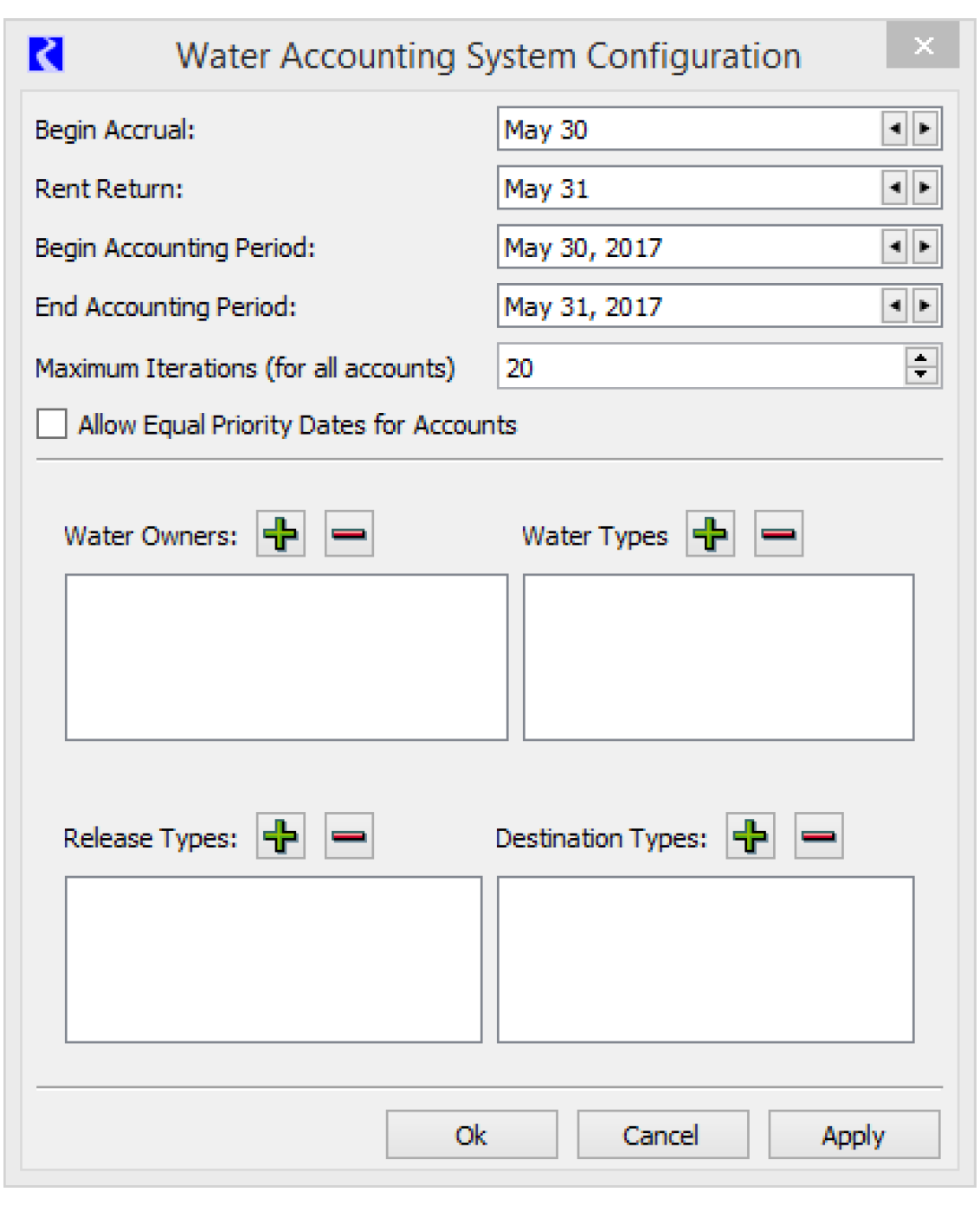Accounting System Configuration
The accounting system is configured separately from the simulation system. In the Water Accounting System Configuration dialog, the user is able to set values that affect the entire accounting system like time range, water type, and water owner definitions.
• Open the Water Accounting System Configuration dialog by selecting Accounting, then Account System Configuration on the tool bar.
Figure 3.1 Water Accounting System Configuration

The Accounting System Configuration includes the following.
Begin Accrual
A Begin Accrual Date is used by storage accounts. On this date, the accrual in each storage and diversion account is reset to zero. In addition, this date is used by the carryover methods on the account.
Rent Return
A rent return date can be configured for the entire accounting system. Currently, this value is not used anywhere.
Begin Accounting Period
An accounting run, like a simulation run, has a period of dates for which accounts solve. The Begin Accounting Period is where the users sets the time range of the accounting system. The date can be before the initial simulation timestep but cannot be after the initial simulation timestep.
End Accounting Period
The End Accounting Period is where the user sets the timestep where the accounting system ends. The end timestep can be after the last simulation timestep but cannot be before it. In other words, the accounting system must cover the entire simulation time but can extend beyond it in either direction.
As a model evolves, you might change the run times (start, finish, timestep size) with the Run Control dialog (Control, then Run Control Panel). Objects created before the changed run times will differ from objects created after the changed run times. Similarly, accounts created before the run time change will differ from those create after the run-time change with respect to their slots’ time ranges and timestep sizes. RiverWare copies the run time information from the run controller to the accounting system so that it knows if there is a possibility that accounts are not synchronized with the run control information.
Max Iterations
As with the physical system, slots in the accounting system can be set many times in a run. The accounting system configuration dialog box allows you to put a limit on the number of times that any slot can be set; if that limit is exceeded for any slot, the run aborts with an error message. Be careful to set this limit high enough for the solve-into-the-future behavior of some accounts.
Below the Max Iterations are areas of the dialog that can be used to define Water Owners, Water Types, Release Types and Destination Types. Each one can be added by selecting the icon or deleted using the
icon or deleted using the icon.
icon.
 icon or deleted using the
icon or deleted using the icon.
icon. Allow Equal Priority Dates for Accounts
This toggle controls whether the accounting system will allow accounts to have priority dates that are the same, or if each account’s priority date must be unique. Priority dates are used to allocate water in rules functions.
Water Owners
Each account can have a water owner which is used to classify the account. The Water Owners area allows the user to create the set of water owners available to the accounts.
Water Types
Each account can have a water type associated with it. The Water Types area allows the user to create the set of water types available to accounts.
Release Types
Release Types are used to classify supplies. The Release Types area allows the user to create the set of release types available to supplies. For example, the user can specify that there are Fish and Irrigation Release types. The release type applies to a supply, this is the water coming out of or going into an account. We will not add release types at this time.
Destination Types
Destination Types are also used to classify supplies. The Destination Types area allows the user to create a set of Destination Types available to supplies. Both Destination Types and Release types become very useful when using the rule controller to define how much and from where water is released.
Units
Prior to version 6.3, you configured accounting specific units in the Accounting System Configuration. Now units are specified in the active Unit Scheme; see Unit Schemes in User Interface for details. See Slots for information specific to accounting units.
Note: Supply Name Format: Although not specified in this dialog, the supply name format can be configured; this is another system configuration that you may want to do before building a model. The format for supply names can be controlled by the user in the Supply Name Format dialog. See Supply Name Format for additional information. The format specified in this dialog is applied to new supplies and can be applied to existing supplies from the Supply Manager.
Revised: 01/10/2022